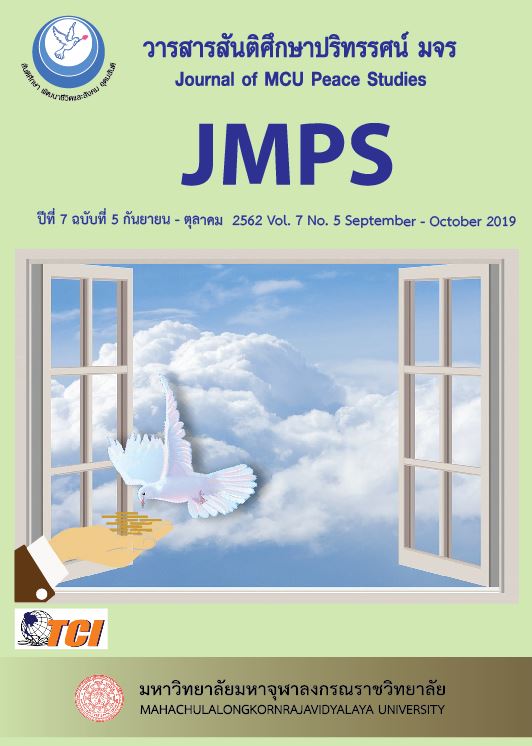Question Structures from A Movie in L2 English Learns’ Writing Based on Government & Binding Theory: A Case Study of Business English Student, Suan Sunandha Rajabhat University*
Main Article Content
บทคัดย่อ
Asking and answering questions play important role in everyday life communication. Thai and English question structures are different in terms of fi rst and second language learning. The aims of this study are to explore the students’ ability on question writing through a movie in english learning and analyze those question structure types. This is a qualitative research. A purposively sampling group is 199 students majoring in Business English, Suan Sunadha Rajabhat University. Data collection instruments are two parts of question-answer reported forms. The movie was divided into nine parts; the students were assigned to make three questions and answers after watching nine parts of the movie called “The Devil wears Prada” at least 27 sentences for each students. It is an outside the classroom activity for 15 weeks in English for Secretary and Advertising I, 2016-2017 academic year. The data were analyzed by Government & Binding Theory: transformational rules. The 190 ungrammatical sentences (from overall 3,176 wh-questions) were selected to be analyzed. The similar questions were excluded. The results show that: from wh-question types: what, when, where, why, who, whom, which and how. The most who-questions students chosen and made mistakes are: why-structure (110), how (19) and what (17) are respectively. Considering the transformational rules used are as “Why with VP negation” with Surface structure (SS): Why did Andrea not come to the company ahead of time to prepare for work for the first day? [CP why [C did [IP Andrea not come to the company ahead of time to prepare for work for the first day]]]. Transformational rules are used as: 1) Negation, 2) Subject –to-Subject raising, 3) Infinitival clause, 4) Wh-movement, 5) Do-insertion, and 6) Inversion. English writing process is more complex for english second learners (L2). Those are not getting familiar by Thai students. It reflects that Thai interference is one of the reasons for these types of syntactic errors.
Article Details
ทัศนะและความคิดเห็นที่ปรากฏในบทความในวารสาร ถือเป็นความรับผิดชอบของผู้เขียนบทความนั้น และไม่ถือเป็นทัศนะและความรับผิดชอบของกองบรรณาธิการ ยินยอมว่าบทความเป็นลิขสิทธิ์ของวารสาร
เอกสารอ้างอิง
Anugkakul, G., Wongsothorm, A. & Person, K., (2017). Learning Styles of Students at Suan Sunandha Rajabhat University. Research and Development Journal Suan Sunandha Rajabhat University.Vol.9 No.2 July-December.
Brenes, C.A. (2017). Observing Students’ Syntactic Errors and the Perceptions towards Writing In the Composition Course. Káñina, Rev. Artes y Letras, Univ. Costa Rica XLI (1) (marzo-agosto): 109-130, 2017.
Graddol, D. (2006). English Next. Retrieved May 15, 2016, from http://vigdis.hi.is/sites/vigdis.hi.is/files/images/einangrun_enskumaelandi_folks.pdf.
Harmer, J. ( 2004). How to Teach Writing. United Kingdom: Longman.
Ismaili, M. (2013). The Effectiveness of Using Movies in the EFL Classroom – A Study Conducted at South East European University. Academic Journal of Inter-disciplinary Studies, Vol 2 No 4, May 2013. University of Rome: MCSERCEMAS-Sapienza.
Kusumarasdyati. (2004). Listening, Viewing and Imagination: Movies in EFL Classes. 2nd International Conference on Imagination and Education Vancouver, Canada, July 14 – 17.
Leonard, L. B., & Loeb, D. F. (1988). Government-binding theory and some of its applications: A tutorial. Journal of Speech & Hearing Research, 31(4), 515-24.
Li, H. (2013). The Analysis of Application about English Original Films in Oral English Teaching. 2nd International Conference on Science and Social Research(ICSSR 2013).
Luo, J. J. (2004). Using DVD films to enhance college freshmen’s English listening comprehension and motivation. Unpublished thesis Master, National Tsing Hua University, Hsinchu. Taiwan, R.O.C.
Mycock, l. (2005). ‘Wh’-in-situ in constituent questions. Proceedings of the LFG05 Conference University of Bergen. Bangkok: CSLI Publications.
Question in English. (2018). Espresso English Company. Retrieved July 3, 2018, from https://www.espressoenglish.net/an-easy-way-to-form-almost-any-question-inenglish/
Santacruz, T.E. (2012). Improving Listening and Speaking Skills for Teaching English Through Film Based Activities for Students of Science Classes at Maria Auxiliadora High School of Cuenca. (Thesis). Ecuador: Universidad de Cuenca.
Yordchim, S. (2014). Error Analysis of English Inflection among Thai University Students. World Academy of Science. Engineering and Technology International Journal of Social, Management, Economics and Business Engineering. Vol:8(7).
Yordchim, S. (2016). English Teaching Methods through Project-Based Learning in English For Marketing and Advertising Course. Proceedings of The IRES 30th International Conference, Tokyo, Japan, 18th February


